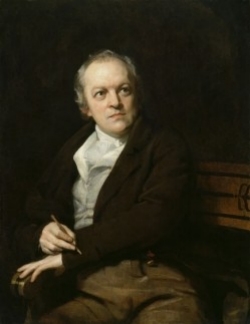The son of a middle-class tradesman in London, William Blake received vocational training rather than a classroom education. Enrolled in drawing school at age 10 and apprenticed to a master engraver of book illustrations and prints by 15, a steady and predictable print shop career awaited. Blake’s personal artistic inclinations—nourished by the importance of books and reading in his family—developed in parallel, and he began to write poetry around age 12. He later enrolled in the Royal Academy of Art to study painting but dropped out after a year, finding the teachings incompatible with the direction of his work. Gradually, Blake merged his writing with visual media—prints, watercolors, and drawings—in a uniquely expressive form of illuminated poetry. He eventually established his own commercial printing shop, which allowed him the freedom to use his own printing presses and self-publish his lavishly illustrated volumes.
Blake’s dedication to his personal art was ambitious and uncompromising. He was drawn to epic themes that gave expression to his deeply held beliefs about the fallen condition of humanity, the pervasiveness of evil and oppressive forces, and states of spiritual and moral crisis. His works make little reference to reality; they are images of a parallel cosmos held in Blake’s imagination. This alternate universe was fueled by his extensive reading of the Bible, mythology, Milton, and other literature but also reflected in his study of art history. During his training as an apprentice engraver, for example, he spent hours drawing the Gothic architecture of Westminster Abbey. There, he absorbed the lessons offered by the cathedral’s stylized forms, line, and symmetry, echoes of which can be seen in his art. Other sources—medieval illuminated manuscripts and the engravings of works by Renaissance artists such as
His work’s originality and sometimes graphic content as well as the eccentricity of his character led some of Blake’s peers to question his sanity and mental stability, according to contemporaneous accounts. The artist had visions of angels or spirits, the first of which occurred at age 10 when he saw “a tree filled with angels, bright angelic wings bespangling every bough like stars.” Such experiences were a source of inspiration for the artist and he recorded them in letters and writings.





